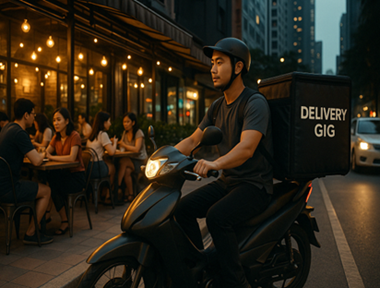Both campuses have become a big draw for visitors and prospective students. How can they minimise the disruption and use this to their advantage?
It's not something you'd typically expect as you walk into your university for a seminar or to conduct a class: a three-generation family posing in front of one of the campus buildings, while another family member crouches down with an outstretched mobile phone to snap a picture.
The phenomenon of international visitors on Singapore campuses was in the headlines recently but actually, tourist interest in our universities, at least the National University of Singapore (NUS) and Nanyang Technological University (NTU), has always been there.
But the tourist numbers have grown. Students and staff have reported noisy tour groups with megaphone-toting guides, packed internal shuttle services (which are free incidentally), as well as people posing for multiple shots or videos at traffic crossings, affecting traffic flow. In fact, at one particular photo hot spot in front of NTU's The Hive (the building that resembles stacked bamboo dim sum containers), the university has had to put up a sign to tell visitors not to stand on the road to take photos.
One friend, who works in NTU's Nanyang Business School, shared that he was accosted by middle-grade students from China who were practising their language skills and conducting a survey in English. Presuming they were part of a student tour, he duly obliged but also hoped they weren't too disruptive to regular campus life.
As the tourists increase, you tell friends who don't work in the universities and there is eye-rolling and curious smiles. Yes, they can understand Oxford and Cambridge, with the bucolic romance of ye olde England and a history that stretches back over eight centuries, appealing to international tourists, but NUS and NTU? And such a trek out of the city!
Friends ask where these tourists come from. While there's no ready information, based on conversations with fellow students and staff, I say the gawking tourists appear to be mostly from China and South Korea. Top ranked in Asia
A quick scan on Chinese-language online sites gives you more clues: There are tours to NUS and NTU, usually packaged as a one-day affair, available for booking. These highlight the sterling reputations of Singapore's tertiary institutions. One knows how the Chinese and Koreans value quality education and imagines them to be cognisant of international rankings.
Looking at the QS World University Rankings, NUS' ranking at eighth is the highest in Asia, higher than that of Peking University, China's top university, which stands at 17th. The next Chinese university is Tsinghua at 25th, while NTU is 26th. South Korea's highest-ranking university is Seoul National University in 41st place.
For a small island to host two top universities must be quite amazing to these visitors.
So it should not come as a surprise that both NTU and NUS are seen as aspirational universities for the younger visitors. Tours also often feature a meal at one of the campus canteens, and one Chinese language website assures tour participants (and presumably prospective students) that the food is suitable for Chinese palates.
But of course, the raison d'etre of any university is to provide a conducive learning environment for their students, not an enjoyable day out for visitors. It doesn't help that NTU has some scenic spots which keep getting recommended by social media. Aside from The Hive, there is the former Nantah library and administration, an important national monument, and now the Chinese Heritage Centre. NUS offers many photo spots too, including the expansive lawn in front of University Town, the Yong Siew Toh Conservatory of Music and the Lee Kong Chian Natural History Museum.
Ah, the curse of iconic architecture and being too Instagrammable.
The reality is that some tourism sites are not intentionally designed for that purpose. They just organically attract visitor interest over time, thanks to word-of-mouth buzz and viral social media.
Think about the row of ornate Peranakan shophouses in Koon Seng Road in Katong or the Old Hill Street Police Station, famed for its brightly coloured windows, which currently houses two government ministries. Tourists regularly flock to these locations to snap their selfies and wefies. In small numbers, this shouldn't be a problem. But when the numbers grow, the tourists can become a nuisance and disamenity, even posing a safety risk as they crowd along busy roads.
Past a tipping point, the only way is to introduce some "friction" at these spots to manage the crowds, perhaps with the intervention of the municipal or transport authorities. This is no different from what NTU did by imposing a fee on tour buses. (Not surprisingly, the 40-seater tour buses have largely disappeared, though much smaller groups of visitors, who presumably arrive by other means of transport, still appear on campus.)
Tourism products that are fit for purpose are clearly designed upstream. The economics have been weighed and they have the international visitor at the heart of the experience. And where the Government gets involved, such as with the allocation of land leases or the awarding of grants as an incentive, the calculation must be the overall benefits it would bring to the country.
In Singapore, we have the two integrated resorts with their casinos, the Universal Studios theme park and other lifestyle offerings, which were put together to attract the tourism dollar. Beyond the bricks and mortar, there are of course tourist-centric events like A-list pop star concerts (cue: screaming Taylor Swift fans) which, as we have seen recently, can bring in visitors while burnishing a country's reputation for clockwork efficiency and warm hospitality.
One can imagine the upstream planning and attention to detail to make sure Swift's concerts happened here and that they were successfully run.
Our university campuses were not designed with tourists in mind. So what can they do about the flood of visitors?
Surely we won't want to go the extreme way of Xiamen and Wuhan universities in China, which have had to restrict visitors and require tickets? Both universities are known for their sprawling grounds, scenic lakes and distinctive Eastern-Western architecture.
Wuhan University has cherry blossom trees which are wildly popular in spring, and Xiamen University, which I visited last year as part of my PhD research, has a Singaporean connection in its philanthropist founder Tan Kah Kee. While I had to pre-register with a helpful professor there, and had the minor hassle of a face scan at the campus gates, I could see how distracting it must be for staff and students to be overwhelmed by the crush of tourists on a daily basis.
But even if they are not "tourism attractions", surely our own universities could capitalise on the growing visitor interest to their advantage? After all, if they form a good impression, young visitors could become tomorrow's undergraduates and postgraduates.
I suspect there are clever ways to mitigate the downside of tourist crowds, including scheduling more tourist activity for off-peak periods and holidays.
Take Harvard University in the United States, for instance (currently fourth on the QS rankings). It offers tours by approved tour companies hosted by their undergraduates. This surely translates to income opportunities for their students, better management of tourist numbers, and possibly even having a view on an approved script and tour route. A well-run tour experience is also a positive branding opportunity for the university.
NUS has announced setting up a pop-up visitor centre to facilitate visits during the coming summer vacation season. But both universities may want to think about a permanent arrangement as their reputations grow.
Also, both universities have museums and centres that are set up for visitors and public education. So being too tight about tourists also doesn't make sense. NUS has its Lee Kong Chian Natural History Museum, with its must-see sauropod dinosaur fossils, while NTU has the Chinese Heritage Centre which champions research and knowledge about ethnic Chinese communities around the world. These non-profits also rely on ticket revenues and donations for their upkeep and operations, so having a flow of tourist groups is critical.
While Singapore universities must focus on research and transformative education for their students, they surely can also find ways to welcome overseas visitors keen to experience a slice of campus life. Still, I will echo the caveats from some of my fellow schoolmates: We would like visitors to have a genuine interest in varsity life, not obstruct traffic, and yes, we would like to find seats in the canteen during lunchtime.
Paul Tan, a third-year PhD candidate at Nanyang Technological University, has worked at the Singapore Tourism Board and the National Arts Council.
Source:
The Straits Times







